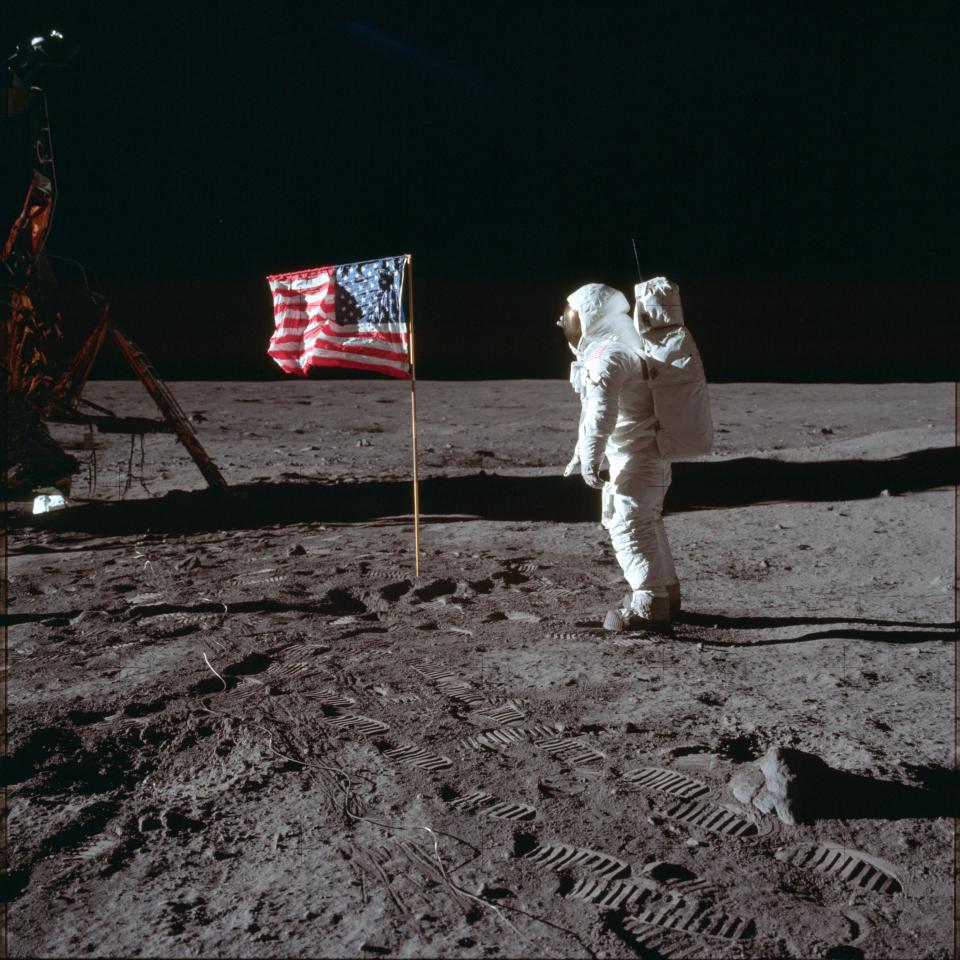'For All Mankind' fact check: How Apple TV's space series mirrors real moon-landing history
Spoiler alert: This story contains plot details from the first three episodes of Apple TV+'s "For All Mankind."
CULVER CITY, Calif. – Would you believe they put a comrade on the moon?
That’s the history-breaking premise of “For All Mankind,” the Apple TV+ drama (now streaming) that imagines what would have happened if the Soviet Union beat the U.S. to a lunar landing.
That bit of alternate history creates a geopolitical butterfly effect that's more uplifting than apocalyptic, the story direction that more typically follows creative tampering with real-life events.
“This truly is an optimistic show,” says executive producer Ronald D. Moore (“Outlander," “Battlestar Galactica"). "The premise is that by losing the race for the moon, we actually won so much more. The country and the world are really put on a more positive path."
Fiddling with what every fifth grader knows requires a grounding in facts to make the story believable, Moore says from the "Mankind" Mission Control set. "If you're going to present the audience with something that is fundamentally unreal and fantastical, the closer you can make it to reality … the (more willing the) audience is to take the fantastic leap with you."
He's standing in front of screens showing pictures of the moon and trajectory graphs on the show's set earlier this year, evidence of its attention to detail. NASA notebooks and flight-plan sheets are arranged at a bank of gray consoles where mission personnel monitor space flights, with empty Beer Nuts bags and Coke cans offering proof of human refueling efforts.
Joel Kinnaman, who plays fictional astronaut Ed Baldwin, says "Mankind" differs from his sci-fi projects, such as "Robocop" and "Altered Carbon."
"It doesn't really feel like science fiction because … it's still rooted in the science of that time," he says. "It just shows you where we could have been if we had not stopped the innovation and if we hadn't de-funded NASA."
Let's take a look at what "For All Mankind" says happened, and what really did – and how a change in the first man on the moon leads to an intriguing series of events:
"Mankind" premise: The Soviet Union shocks the U.S. with a surprise moon landing in June 1969, leading America to reshape its space program, eventually leading to changes in foreign policy and domestic attitudes.
More: Apple TV+ series reviewed, from 'Morning Show' to 'See'
In reality, Americans Neil Armstrong and "Buzz" Aldrin set foot on the moon on July 20, 1969, with colleague Michael Collins orbiting above. All three are depicted in "Mankind" but only as background characters.

Who's who? Apollo 10 is piloted by fictional astronauts Baldwin (Kinnaman) and Gordo Stevens (Michael Dorman), but it otherwise gets historical details right, from the flight's role as a moon-landing dress rehearsal to the command and lunar modules nicknamed Charlie Brown and Snoopy. Off duty, they chug beers at Houston's Outpost Tavern, a real astronaut hangout in the 1960s.
The characters are surrounded by historical figures, including Wernher von Braun (Colm Feore), the ex-Nazi scientist behind both the German V-2 rocket and the Apollo launch vehicle; astronaut office head Deke Slayton (Chris Bauer); Mission Control chief Gene Krantz; and NASA administrator Thomas Paine.
More: What would have happened if the Soviets landed the first man on the moon?
To infinity … and beyond: In "Mankind," the surprise Soviet landing leads President Richard Nixon, seen in archival footage, to escalate the U.S. space program as the superpower rivalry moves into space, with ambitious plans for moon bases and flights to Mars and beyond.
In reality, there's long been talk of manned flights to Mars, but it hasn't had anywhere near the intensity of the '60s space effort. The last moon landing was in 1972.
Flight change: In "Mankind," the superpowers' decision to amp up the Cold War in space changes policy and budget priorities. America gets out of the Vietnam war in the early 1970s, a few years earlier than the real war's conclusion in 1975. The Soviet Union doesn't invade Afghanistan.
Teddy ready? The surprise Soviet moon landing leads U.S. Sen. Edward "Ted" Kennedy to return to Washington, D.C., for related hearings, canceling his plans to attend a party on Chappaquiddick Island. His rising profile and Kennedy lineage could result in a huge reelection challenge for Nixon in 1972. Does that mean no Watergate?
In reality, Kennedy drove a car into a pond on the Massachusetts Island on July 19, 1969, resulting in the death of passenger Mary Jo Kopechne. Kennedy pleaded guilty to leaving the scene of an accident, and the resulting stigma reportedly influenced his decision not to run for president in 1972. (Nixon was reelected in a landslide.)
Equal rights in space? The Soviet Union springs another surprise in "Mankind," putting the first woman on the moon in 1969. That leads NASA to rush to find a female astronaut, assembling a field of candidates that includes Stevens' wife, Tracy (Sarah Jones). Those candidates become role models for a generation of girls, paving the way for accelerated advances by women.
In reality, Soviet cosmonaut Valentina Tereshkova was the first woman in space in 1963, and no woman has been to the moon. "Mankind" shines a light on a real-life group more people should know about: the Mercury 13, a group of women who underwent the same screening tests as the men selected as Mercury astronauts in the 1950s.
More: Ranked: All the major streaming services, from Netflix to Apple TV+ to Disney+
This article originally appeared on USA TODAY: 'For All Mankind' fact check: Apple series and real space history

